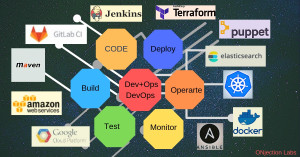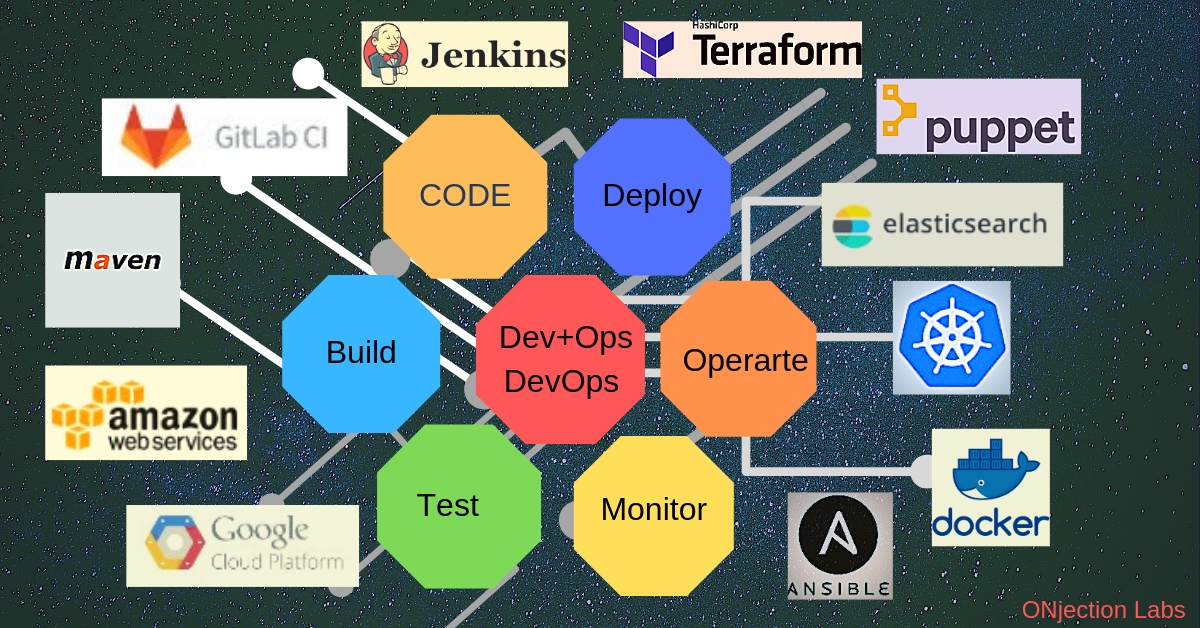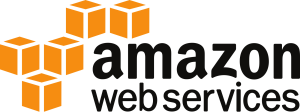In this growing era of technology, it becomes mandatory to go with the latest technology. In 2018 we have witnessed a pool of new technology which is voice technology, chatbots, artificial intelligence and at last but not least DevOps technology. All these technologies become a part of IT solutions and apart from that, all IT developers are fetching new opportunities to grow from this emergent field of technology.
In such a situation, most of the organizations are thinking of adopting DevOps services to expedite the software development process. When anyone thinks of implementation of DevOps, a catalog of DevOps tools opens up. As a beginner it’s becomes very challenging to apprehend and classify all the different tools of DevOps technology.
Let us elucidate the DevOps tools which anyone can use to automate the development, testing, and deployment operation using Continuous Integration/Continuous Deployment pipeline using below tools.
Different Categories of DevOps Tools
DevOps Cloud Tools: AWS, Google Cloud Platform
First of all, we need computing resources such as Server/VM, Network and Storage to deploy applications on it. Public cloud services are generally being offered as a pay-per-usage model. There are several Public Cloud competitors present in the market and everyone has its own pro and cons. Some of the big names are Amazon Web Services, Google Cloud Platform, and Microsoft Azure. Let’s have a quick comparison of both
Amazon Web Services: Gartner Says AWS has 51.8 % of the total market share of Worldwide IaaS Public Cloud Services Market. All the services in AWS have APIs, which allow the DevOps engineers to follow the Infrastructure as Code principles. AWS has a huge variety of in-house advanced DevOps tools which includes :
- AWS CodeCommit
- AWS CodeBuild
- AWS CodeDeploy
- AWS CodePipeline
- AWS OpsWork
Google Cloud Platform: Google’s Cloud is the better choice when it comes to computing and storage costs and also Google cloud provides $300 of free credit to use. Google Kubernetes Engine provides production-ready Kubernetes environment for deploying containerized applications. 
Conclusion: There is no clear winner here. Cloud platform should be selected depending upon the requirement and use case.
CI/CD pipeline tools: Jenkins, GitlabCI
Continuous Integration tools are required for the implementation of the CI/CD pipeline. These tools are used to define multiple stages like Static Analysis, Deployment, Testing, and Cleanup. On every code check-in, CI tool will execute the pipeline using the checked-in code. Most of the tools are available as open-source. Some of the options are:
Jenkins: Jenkins is one of the earliest open-source continuous integration servers and remains the most common option in use today. The CI process can be defined either declaratively or imperatively using the Groovy language in files within the repository itself or through text boxes in the Jenkins web UI. Jenkins has a huge amount of plugins for almost everything and also has great integration with IDEs like Eclipse and Intellij Idea.
GitlabCI: The CI/CD process in GitLab CI is defined within a file in the code repository itself using YAML configuration syntax. The work is then dispatched to machines called runners, which are easy to set up and can be provisioned on many different operating systems. When configuring runners, we can choose between different executors like Docker, shell, VirtualBox, or Kubernetes to determine how the tasks are carried out.
The tight coupling of GitLab CI with the GitLab repository platform has definite implications on how the software can be used.
Conclusion: Jenkins is a better choice for the production-ready system due to the variety of plugins available.
Orchestration Tools: Terraform
Cloud orchestration is typically used to provision, deploy or start servers; acquire and assign storage capacity; manage networking; create VMs, and gain access to specific software on cloud services.
Orchestration tools are being used to write your Infrastructure as Code.
Terraform is compatible with almost all the cloud platform. Provider list is attached: https://www.terraform.io/docs/providers/
Conclusion: Terraform is a clear winner here due to its compatibility with multiple clouds.
Configuration Management Tools: Chef, Puppet, Ansible
Chef, Puppet and Ansible are all “configuration management” tools, which means they are designed to install and manage software on existing servers but which one should we use:
Chef: Chef has master-agent architecture. Chef server runs on the master machine and Chef Client runs as an agent on each client machine. Also, there is an extra component called workstation, which contains all the configurations which are tested and then pushed to central chef server. Therefore, it is not that easy.
Puppet: Puppet also has master-agent architecture. Puppet server runs on the master machine and Puppet clients run as an agent on each client machine. After that, there is also a certificate signing between the agent and the master. Therefore, it is also not that easy.
Ansible: has only master running on the server machine, but no agents running on the client machine. It uses ssh connection to log in to client systems or the nodes you want to configure. Client machine VM requires no special setup; hence it is faster to set up!
Easy to learn and manage the configurations as it uses YAML i.e. yet another Markup Language which closely resembles English. Server pushes configurations to all the nodes. Good for real-time application and there is immediate remote execution.
Conclusion: Ansible is a clear winner here as it is easy to set up and scale.
Container Deployment Tools: Docker Swarm, Kubernetes
LXC (Linux Containers) was first introduced in 2008 but container management was always a pain. Latest container management software does not only simplify the deployment but also help in updates and rollouts of container deployment.
Some of the popular Container deployment tools are:
Docker Swarm: In Docker swarm, applications can be deployed as services (or micro-services) in a Swarm cluster. YAML files can be used to specify multi-container. Moreover, Docker Compose can deploy the app. It is easy to set up but it is not a powerful tool.
Kubernetes: Kubernetes is an open-source container-orchestration system for automating deployment, scaling, and management of containerized applications. It was originally designed by Google and is now maintained by the Cloud Native Computing Foundation. It is difficult to install but very powerful tool. It provides scheduler, rolling upgrades, health checks, and auto-scaling. It also has Helm which is useful for deployment of microservice.
Conclusion: Better choice here is Kubernetes as it is powerful but to ease automation, it can be deployed using Google Kubernetes Engine, Kops on AWS.
After having complete information about DevOps tools, now it becomes easy for business owners to choose the right DevOps service partner. At ONjection Labs we always keep our DevOps Developers up to date with the latest technology and trends to bring out the best business solutions so that our clients can cater to more customers.



